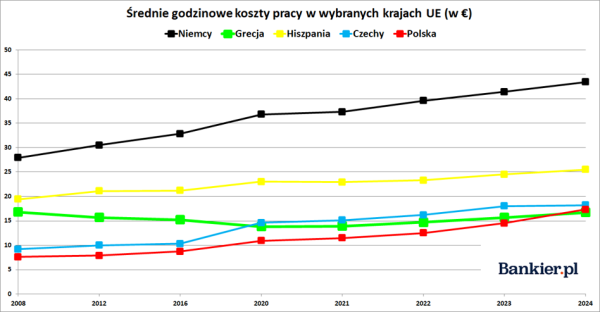In 2024, Poland recorded one of the fastest increases in labor costs in the European Union. However, the rates paid to employees on the Vistula and Oder remain significantly lower than those in Western Europe.

At the end of March, Eurostat published data on the average hourly cost of labour in the European Union countries. This statistics includes not only the “bare” wages paid to employees, but also taxes and “contributions” to social benefits paid by the employer. (The English euphemism for this procedure is called “non-wage costs”). This is therefore the so-called large gross – i.e. the hourly gross rate in the Polish case increased by 20% of “contributions” to ZUS formally remaining “on the side” of the employer.


Eurostat
According to Eurostat data, in 2024 the average hourly labor cost in Poland was €17.3. This data only applies to the sector of enterprises employing at least 10 people. Therefore, it does not include micro and small companies, agriculture, the public sector or uniformed services. The result for Poland was similar to other countries in our region: Lithuania (€16.3), Croatia (€16.5), the Czech Republic (€18.2) and Slovakia (€18.5). It is worth noting that this result was significantly higher than in Hungary (€14.1) and Romania (€12.5), and even slightly higher than in Greece (€16.7).
Read also
5,000 PLN net. More than half of Poles earn less
However, we are still far from the levels recorded in “old Europe”. The average for the entire EU was €33.50 per hour and was inflated by countries such as Germany (€43.40), France (€43.70) or the Netherlands and Ireland (€45.20 each). The highest hourly rates were in Belgium (€48.20) and Denmark (€50.10). Even better were paid in EFTA countries outside the EU: in Norway it was €53.70 and in Iceland €53.
While average rates in Poland are still 2.5 times lower than in Germany, it should be noted that in the past few years we have been quickly closing this gap. In 2024 alone, Polish wages expressed in euros increased by as much as 12.8% year-on-year, which was a result of both a strong increase in nominal wages and the strengthening of the złoty against the euro. Similar (or even slightly higher) dynamics of the “euro” hourly rate were observed in Hungary, Bulgaria and Romania.


Bankier.pl based on Eurostat data
It is also worth comparing salary data in the longer term. In 2016, the average hourly rate in Poland (i.e. gross) was only €8.7, which was slightly over a quarter of the salary of an employee in Germany (at that time: €32.8). Last year, it was already 40%. So, in the last few years, Polish salaries have been quickly catching up with salaries in wealthier European countries. Although we still have a long way to go to catch up with the leaders, European averages like Spain (€25.5) or Portugal (€18.2) may soon be within our reach.
Of course, the salary coin has two sides. On the one hand, we are happy that as employees (and the whole society) we are earning more and more and at quite a good pace we are catching up with the level of income achieved in the until recently almost mythical “West”. Now, taking into account the differences in the cost of living that are still favorable to Poland (although smaller and smaller year by year), a Polish employee generates purchasing power similar to the value in the countries of the European South. However, on the other hand, Poland is quickly losing price competitiveness in manufacturing industries, especially when performing relatively simple work. It is not only small domestic businesses that are having problems. Even foreign corporations have noticed this, which are increasingly moving factories from Poland to countries with cheaper labor in Africa or the Middle East. And this is a trend that we will have to face in the coming years.






